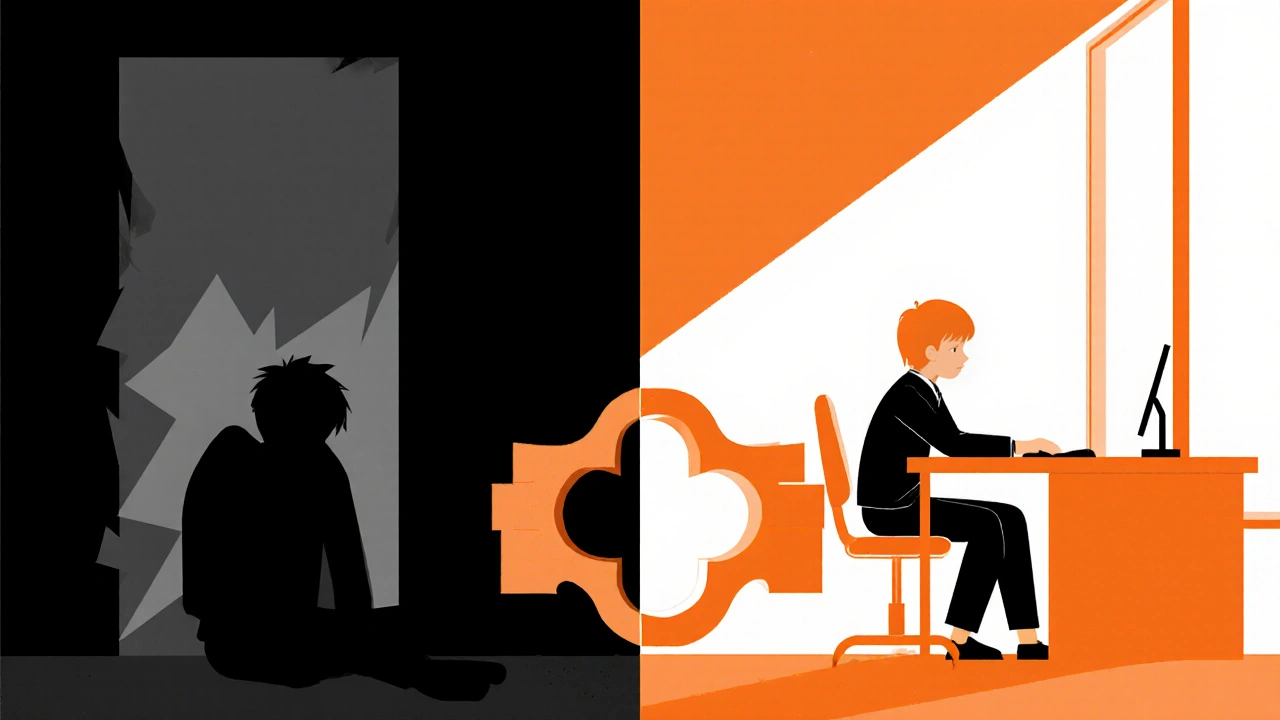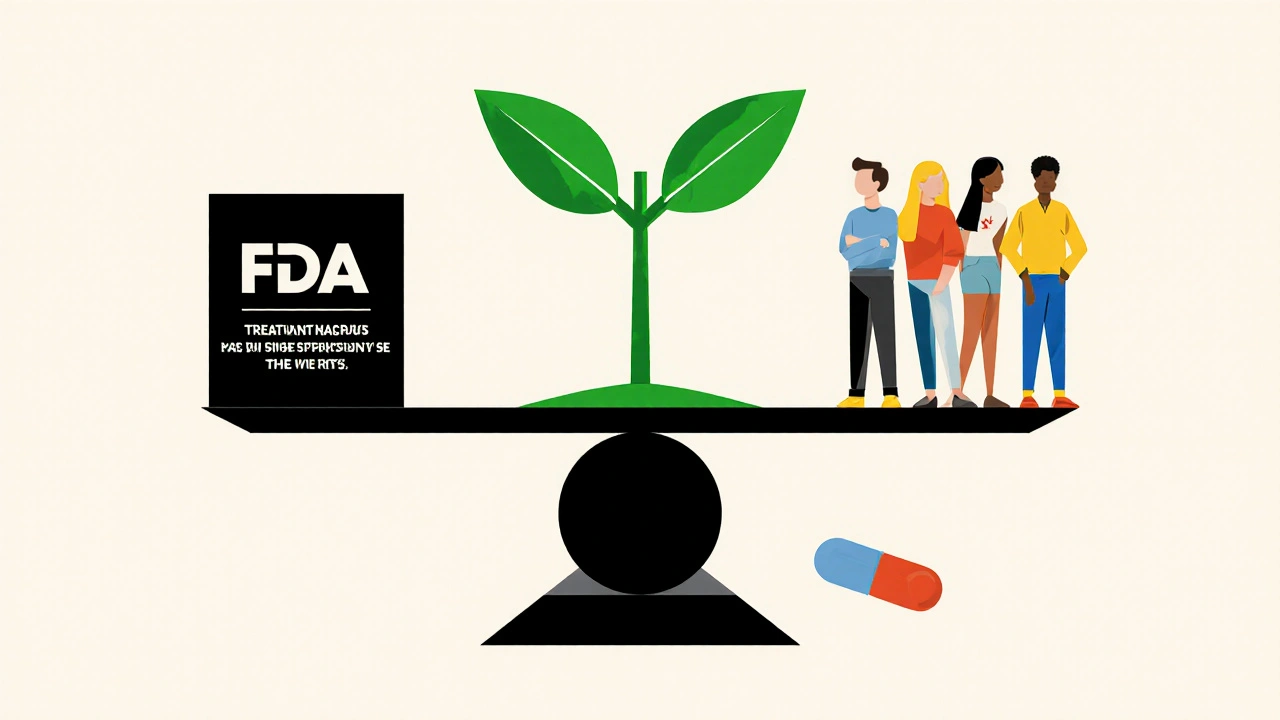Suicidal Thoughts on Antidepressants: What the Black Box Warning Really Means
 Nov, 15 2025
Nov, 15 2025
Antidepressant Risk Calculator
Understanding Your Risk
This tool helps you understand the relative risk of suicidal thoughts when starting antidepressants based on your age and medication type. Remember: the risk is temporary and the benefits of treatment typically outweigh the risks when properly monitored.
Your Risk Assessment
Relative Risk:
Compared to placebo (2% baseline risk)
What the Black Box Warning on Antidepressants Actually Says
When you pick up a prescription for an antidepressant, there’s a bold, black rectangle on the first page of the patient information leaflet. It doesn’t say anything about side effects like dry mouth or weight gain. It doesn’t warn about nausea or sleep changes. It says something far more serious: antidepressants may increase the risk of suicidal thoughts and behaviors in children, adolescents, and young adults up to age 24.
This is the FDA’s Black Box Warning - the strongest safety alert the agency can give short of pulling a drug off the market. It was added in 2004 after a review of 24 clinical trials involving over 4,400 young patients. The data showed that about 4% of kids and teens taking antidepressants had suicidal thoughts or behaviors during the first few months of treatment, compared to 2% on placebo. No one died in those trials, but the increase in suicidal thinking was real enough for regulators to act.
The warning was expanded in 2006 to include all antidepressants and raise the age limit from 18 to 24. That means if you’re under 25 and your doctor prescribes you fluoxetine, sertraline, escitalopram, or any other antidepressant, you’ll get this warning. The FDA didn’t ban any drugs. Instead, they forced manufacturers to put a red flag at the very top of every pill bottle’s information sheet. It’s impossible to miss.
Why This Warning Exists - And Why It’s Controversial
The FDA didn’t make this call lightly. A team of 10 pediatric suicidologists from Columbia University re-analyzed the original drug company data - blind to which patients got the drug or placebo - and confirmed the pattern. The rise in suicidal thinking wasn’t random. It showed up early, usually within the first two to four weeks of starting treatment. It wasn’t linked to dose size or specific diagnoses like OCD or anxiety. It was a consistent signal across multiple drugs.
But here’s where things get messy. While the warning was meant to protect young people, many experts now believe it’s doing the opposite. A 2023 study in Health Affairs looked at 15 years of real-world data after the warning went into effect. What they found was startling: prescriptions for antidepressants dropped by 22.3%. Psychotherapy visits fell by 17.1%. Diagnoses of depression declined by nearly 20%. And suicide deaths among youth rose by 14.9%.
Why? Because fear replaced understanding. Parents, teachers, and even some doctors started avoiding antidepressants altogether. Some teens refused to take them after reading the warning. Others stopped taking them mid-treatment because they panicked. The result? More untreated depression. More self-harm. More emergency room visits for drug overdoses - up 28.6%.
One doctor told me about a 17-year-old girl who had been stable on sertraline for six months. Her mom found the Black Box Warning online, freaked out, and pulled her off the medication cold turkey. Within two weeks, the girl’s depression worsened. She tried to overdose on ibuprofen. She ended up in the hospital. Her doctor said if she’d stayed on the antidepressant, this likely wouldn’t have happened.
Who’s at Risk - And Who Isn’t
The Black Box Warning doesn’t mean every young person will have suicidal thoughts on antidepressants. It means some might. And the risk isn’t the same for every drug.
Studies show fluoxetine (Prozac) has the lowest risk among SSRIs. Sertraline and fluvoxamine also appear safer in younger patients. Paroxetine, on the other hand, has consistently shown higher rates of suicidal behavior in trials. Venlafaxine (Effexor) carries more risk than SSRIs in adolescents. Bupropion (Wellbutrin) doesn’t seem to carry the same risk - and is sometimes used as an alternative when SSRIs cause problems.
It’s also not about age alone. Young adults aged 18 to 24 show a smaller increase in risk than children under 18. Adults over 25? No increased risk. In fact, for adults over 65, antidepressants appear to lower suicide risk.
And here’s something most people don’t know: the warning doesn’t apply to everyone. The FDA explicitly states that the benefits of antidepressants still outweigh the risks for most patients with moderate to severe depression. Untreated depression is the biggest risk factor for suicide. A person with major depressive disorder who doesn’t get treatment has a 15% lifetime risk of dying by suicide. That’s higher than the risk from the medication itself.

What Happens When You Start an Antidepressant
If you or your child begins taking an antidepressant, here’s what you should expect - and what you should watch for.
- Week 1-2: You might feel worse before you feel better. Energy levels can dip. Anxiety might spike. This is normal. It doesn’t mean the drug isn’t working - it means your brain is adjusting.
- Week 3-4: This is the highest-risk window for suicidal thoughts. If you notice new or worsening thoughts of self-harm, hopelessness, or agitation, call your doctor immediately. Don’t wait. Don’t assume it’s "just part of the process."
- Week 5-8: Most people start to feel improvements. Sleep gets better. Appetite returns. Motivation comes back. If you’re still feeling worse after eight weeks, talk to your doctor about switching medications or adding therapy.
Every patient should have a follow-up appointment within one to two weeks after starting the medication. After that, check-ins every two weeks for the first two months. These aren’t optional. They’re life-saving.
Some clinics now use simple screening tools - like asking, "Have you had any thoughts about hurting yourself this week?" - during every visit. It sounds basic, but it catches problems early.
The Real Danger: Misunderstanding the Warning
The biggest problem with the Black Box Warning isn’t the science. It’s the message people take away.
Many think it means antidepressants cause suicide. That’s not true. The warning says they might increase the risk of suicidal thinking in the first few weeks of treatment - especially in young people whose brains are still developing. But the same drugs, when used properly, reduce suicide risk over time.
It’s like a warning on a car: "Do not drive at 100 mph on icy roads." That doesn’t mean cars are dangerous. It means you need to adjust your behavior based on conditions.
When patients stop taking antidepressants because they’re scared, they’re not avoiding risk - they’re trading one risk for a bigger one. A 2019 case study described two teens who refused antidepressants after learning about the Black Box Warning. Both later attempted suicide. Their doctors said the medication likely would have prevented it.
Therapy helps. But therapy alone doesn’t work for everyone. For severe depression, medication is often necessary. Combining medication with cognitive behavioral therapy (CBT) cuts suicide risk more than either alone.

What You Should Do Now
If you’re considering antidepressants for yourself or someone under 25:
- Ask your doctor: "Which medication are you prescribing, and why?" Not all antidepressants are the same.
- Ask: "What’s the plan for monitoring in the first 8 weeks?" Make sure you have scheduled check-ins.
- Ask: "What are the signs I should watch for?" Write them down. Know what’s normal and what’s dangerous.
- Don’t stop the medication suddenly. Withdrawal can make depression worse.
- Don’t rely on Google. Talk to your prescriber. If they dismiss your concerns, find someone who won’t.
If you’re already on an antidepressant and feeling worse:
- Call your doctor. Don’t wait.
- Reach out to a crisis line: 988 is the Suicide & Crisis Lifeline in the U.S. It’s free, confidential, and available 24/7.
- Don’t feel guilty. This isn’t weakness. It’s a medical adjustment.
Where Do We Go From Here?
The FDA still keeps the Black Box Warning on all antidepressants. But in 2022, their Pediatric Advisory Committee acknowledged that the warning might be doing more harm than good. They didn’t remove it - but they did update the language to better explain that the risk is temporary and that untreated depression is far more dangerous.
Experts are now pushing for medication-specific warnings instead of a one-size-fits-all alert. For example: "Paroxetine may increase suicidal thoughts in youth. Fluoxetine has minimal risk." That kind of precision would help doctors make better choices and reduce fear-driven avoidance.
The future of treatment isn’t about banning drugs. It’s about better monitoring, smarter prescribing, and clearer communication. The goal isn’t to scare people away from treatment. It’s to make sure they get the right help at the right time - and stay on it long enough to heal.
Do antidepressants cause suicide?
No, antidepressants do not cause suicide. But in a small number of children, teens, and young adults under 25, they may increase the risk of suicidal thoughts during the first few weeks of treatment. This is not the same as causing suicide. Untreated depression carries a much higher risk of suicide. The goal of antidepressants is to reduce that long-term risk, not create a new one.
Is it safe to take antidepressants if I’m under 25?
Yes, for most people. The risk of suicidal thoughts is small - about 2% higher than placebo - and mostly happens in the first month. With proper monitoring, the benefits of treating moderate to severe depression far outweigh the risks. Fluoxetine and sertraline are considered the safest options for younger patients. Always work with a doctor who will check in regularly.
What should I do if I start having suicidal thoughts while on antidepressants?
Call your doctor immediately. Don’t wait. Don’t try to tough it out. If you can’t reach your doctor, call 988 - the Suicide & Crisis Lifeline. You can also go to the nearest emergency room. These thoughts are a sign your treatment needs adjustment, not that you’ve failed. Many people feel this way early on - and get better with the right support.
Why did the FDA add this warning if antidepressants help people?
The FDA added the warning because clinical trials showed a clear, measurable increase in suicidal thinking among young people in the first weeks of treatment. The agency’s job is to flag potential risks, even if they’re rare. But the warning was never meant to stop treatment. It was meant to make sure people are monitored closely during the most vulnerable period.
Are there alternatives to antidepressants for teens and young adults?
Yes. Cognitive behavioral therapy (CBT) is proven effective for mild to moderate depression. Exercise, sleep hygiene, and family therapy can also help. But for severe depression - especially when someone is unable to get out of bed, stop eating, or think clearly - medication is often necessary. The best outcomes come from combining therapy and medication. Avoiding treatment entirely because of fear increases suicide risk.

Christina Abellar
November 16, 2025 AT 18:02Eva Vega
November 17, 2025 AT 00:58Matt Wells
November 17, 2025 AT 15:01George Gaitara
November 19, 2025 AT 09:13Deepali Singh
November 19, 2025 AT 21:26Sylvia Clarke
November 20, 2025 AT 09:22Jennifer Howard
November 21, 2025 AT 04:58